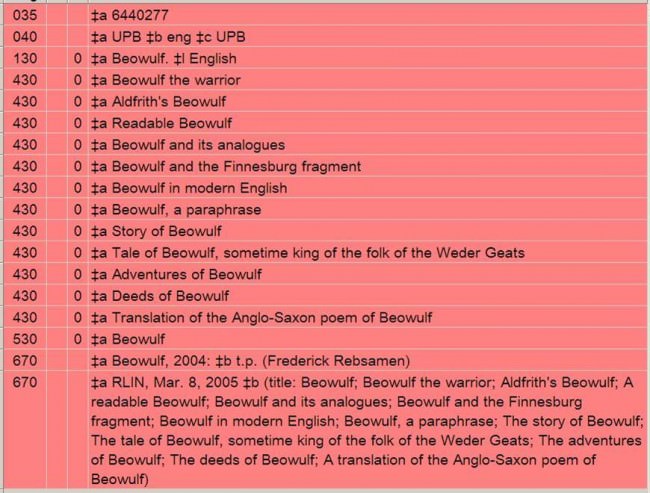NACO Training, MARC21 for Authorities, RDA in NACO Bridge Training, RDA 6.6, 6.12
Policies & Protocols
Source: RDA in NACO Pt. 3, Slide 55
No indicators
Subfields:
| ‡a | Other distinguishing characteristic (R) |
| ‡u | Uniform Resource Identifier (R) |
| ‡v | Source of information (R) |
| ‡2 | Source of term (NR) |
For use of 381 with SARS:
Definition and Policies
Definition: “characteristic other than content type, language of expression, or date of expression that serves to differentiate an expression from another expression of the same work.”
Core when needed to differentiate.
Special instructions for religious works (RDA 6.25)
MARC field 373 (corporate body) 381 (anything else)
- MARC Format for Authority Records has an example for 381 of an issuing body of a series; do not apply; use 373
Scope
Slide 56
Only applicable to Work or Expression NAR’s.
Any defining characteristic other than those already existing as attributes.
- Date, Language, or Content Type already exist, so:
- e.g. Edition, version, publisher name, translator name, arranged statement of music, etc.
Capitalize first letter if appropriate.
Choosing a Characteristic
EXAMPLE 1. Work attribute.
| 130 | 0 | Harlow (Motion picture : 1965 : Douglas) | |
| 046 | ‡k 1965 <release date> | ||
| 380 | Motion picture | ||
| 381 | Douglas |
Expression attributes.
Use whatever distinguishes the expressions best.
- the surname of an editor or translator
- the name of a version
- the name of a publisher closely associated with the expression
- etc. ...
If it makes more sense, the language, the date of the expression, or content type can be used to distinguish instead (RDA 6.9-6.11)
EXAMPLE 2. Expression attribute. For sacred scriptures, the ‡s and ‡f are mandatory.
| 130 | 0 | Bible. ‡l English. ‡s Authorized. ‡f 2004 | |
| 046 |
‡k 2004 <date of publication> |
||
| 381 | Authorized |
EXAMPLE 3. PCC members have the option to create a separate AR for individual expressions that are not sacred scripture or musical expressions , but it means careful updating of the undifferentiated AR if it exists.
YUL policy: do not make without an OK from NCC. On the other hand, examples 1 and 2 are standard practice that YUL should follow if making an AR to qualify the bib record as pcc.
Note punctuation for ‡s element.
| 130 | 0 | Beowulf. ‡l English. ‡s (Heaney) <if a non-sacred scripture/music expression AR for a translation is made, and the AR is intended to represent all English translations, do not add ‡s or 381> | |
| 046 | ‡k 2000 <date of publication; only if separate AR is made for the expression> | ||
| 381 | Heaney <translator; only if separate AR is made for the expression> |
Preferred Title of Expression with No Further Differentiation
Source: YUL
The various English language translation titles have been incorporated into one AR, which is still acceptable. If you cataloged the Heaney translation, 130 _0 ‡a Beowulf. ‡l English is still valid and you can code the bib record as pcc (technically you don’t even have to update the AR coding to rda if the AAP is consistent with RDA. However, if another NACO contributor has created an AR with AAP 130 _0 ‡a Beowulf. ‡l English. ‡s Heaney, use the AR for the specific translation. If the AR has been made, you can code the record as pcc.
